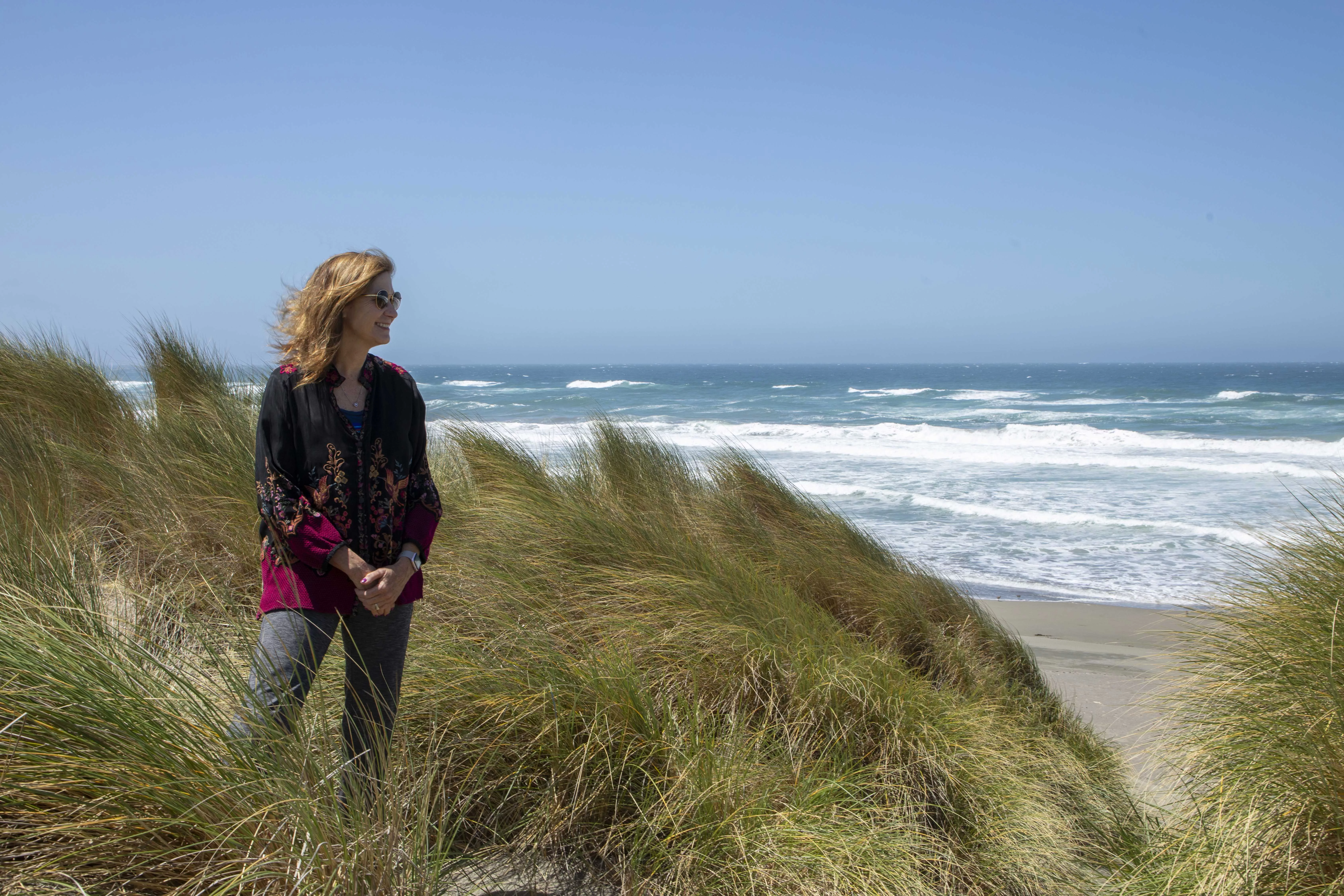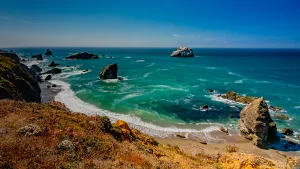
Caryl Hart, shown here at Salmon Creek Beach, part of Sonoma Coast State Park. [Photo by Duncan Garrett Photography]
The California Coastal Commission was established by voter initiative in 1972 and made permanent by the state legislature with the adoption of the California Coastal Act of 1976. The commission performs a wide range of duties to regulate the use of land and water in the state coastal zone.
Caryl Hart, a Sebastopol resident and former director of Sonoma County Regional Parks, was appointed to the commission in 2019, and this year serves as chair of the influential 12-member board.

Hart, 66, developed a passion for environmentalism at a young age. Born and raised in West Los Angeles, she recalls a childhood spent lying under trees and gazing up at the sky—she craved the outdoors. When she was in sixth grade, Hart’s family moved to the Santa Ynez Valley, where they owned a spacious piece of land; she became an immediate fixture at the rolling creek near their house. The seeds of environmentalism were firmly planted, setting her on a path to pursue environmental law.
When considering her career options later in college, the lure of the criminal courtroom shone brighter than that of environmental law, and Hart went on to serve as a public defender in San Francisco and Marin County.
She met her husband Mickey—drummer in a little North Bay-based band called the Grateful Dead—in 1990 and they settled in the Sebastopol area soon after. While her frustrations with life as a public-defender grew—the state’s 1994 incarceration-heavy Three Strikes law was a particular sore point—that lifelong passion for conservation blossomed. In the 1990s, she chaired the Sonoma County open space advisory committee, co-founded parks-advocacy nonprofit LandPaths, and went on to earn an appointment in 2000 to the state parks commission, upon which she served for 13 years.
For seven years beginning in 2010, Hart was director of Sonoma County Regional Parks and, as an encore, served as interim director of the Sonoma County Agricultural Preservation and Open Space Preserve in 2020, about the time of her appointment by then-state Assembly Speaker Anthony Rendon to the Coastal Commission.
From that girl lying beneath the trees of L.A. to leading one of the state’s most powerful land/water-use commissions, the road to conservation has been as long and winding for Caryl Hart as it has been rewarding.
“It’s like any passion…it’s just part of your DNA and who you are,” she says.
We asked Hart about the work of the Coastal Commission, the current challenges facing the California coast—and, most importantly, what’s her favorite local beach.
****

When you first got involved in local land use in the 1990s, Sonoma County wasn’t known for its open space conservation. What changed?
Before I even went to grad school to get my doctorate in environmental policy, I was on the Ag & Open Space Committee—I think I was the chair of that for a period of time. I was also on the State Park [and Recreation] Commission which I was also the chair of. During that period—I moved here in 1990-1991—there was very little parkland or open space in the county. In fact, Sonoma County ranked at the bottom of the list for parkland. With friends and people that I met, we started working on how we could take some of the land that was, for example, in the hands of timber companies and look at whether there was a possibility of those areas becoming a park—a state park.
And here we are today—thousands of acres have been added to state parks.
You always think over your lifetime, what will you remember as something that you really feel good about? I would say it was my involvement in the acquisition of the Willow Creek property. [In 2005, more than 3,000 acres of Willow Creek alongside the Russian River was acquired by and folded into the state parks system; prior to that LandPaths had been its steward.]
Why is Willow Creek so near to your heart?
It was really just being part of the transition of a property that is as magnificent as Willow Creek. It’s essentially a huge watershed, that part of the property is 5,500 acres. But we started working on the whole area, which is now maybe up to 20,000-plus acres. Willow Creek is one of the most spectacular areas, it’s a big redwood property with big meadows and it goes from the top of Coleman Valley Road all the way down to the Russian River. It has an incredible wetland area, it has beautiful meadows, old growth redwoods and it has trails all over. I just love it so much out there and I feel really happy that ended up [within state parks]. It still hasn’t been opened as a state park, which is a disappointment, but it doesn’t take away from the fact that it has been protected permanently. All the creatures that live there and the redwoods can now go about their business of continuing to grow and thrive.
****
Throughout her career with LandPaths, county parks and in other local land-use advocacy roles, Hart engaged regularly with the California Coastal Commission—so the commission was very much on her radar when a seat opened in 2019. Two years removed from her tenure with regional parks, she decided to pursue a spot on the powerful coastal board, earning her appointment from then-Assembly Speaker Anthony Rendon later that year.
According to the CCC website at coastal.ca.gov, “the commission is committed to protecting California’s coast through careful planning and regulation of environmentally sustainable development, rigorous use of science, strong public participation, education and effective intergovernmental coordination.”
Of all the service opportunities open to you, why the Coastal Commission?
I had such an incredible admiration for the work of the commission and everything they have done. I began to explore how it was possible—how the appointment process worked. The Senate, the Assembly and the Governor each have four appointees—and at the time the commission was full. But I had some friends that worked in the Speaker’s [Anthony Rendon] office and another friend of mine that worked in Sacramento on parks issues and they reached out to me and said that the Speaker might have an opening. So, I went and met with [Rendon] and talked to him about it. I pursued it by the usual route—with recommendations and people sticking up for me.
Finally being awarded the appointment must have been very satisfying.
When I got the award, I was super excited—but I really didn’t know what I was in for, [only that] it was an opportunity for me to really dig in and get involved in protecting the coast of California. I’ve been on for a little over four years and it’s been great.
What are your other commitments beyond the commission?
Since the legislative session has started—I’m part of the Legislative Committee—there’s been some legislation that was concerning to the commission, and I have had to engage on that. And on top of the coastal commission, I am now on the Coastal Conservancy board—which is the land acquisition board for the state coastal zone. I also chair the Great Redwood Trail Agency, which is about creating a trail from the San Francisco Bay to the Humboldt Bay. It’s been much more intense than I would have thought, it’s really like full-time, plus.
For a long time, state agencies and commissions were typically led by men. How is that changing?
Well, all I can tell you is, currently on the Coastal Commission, its either nine or 10 of the 12 [commissioners] are women. In terms of the California state government, in terms of the resources side, the director of the Coastal Commission is a woman, the director of the Coastal Conservancy is a woman, the director of the Ocean Protection Council is a woman—I mean it’s really crazy.
Has it been a concerted effort to level the playing field?
I think at least in my field, there is a real openness and a desire for more women to move up—particularly women from more diverse backgrounds. It’s really an emphasis. I would say if you are interested in the environmental field and county or state government, state government, that sort of thing—it’s a really good time. But you have to do the work; you’re not going to get anywhere if you don’t put in the time. I am a big advocate for graduate school. Taking the time; I’ve seen it for so many people make a huge difference in their lives.
****
Hart concedes there is a lack of public awareness about the day-to-day operations of the California Coastal Commission. One common misconception, she points out, is that the commission denies housing along the coast. In reality, says Hart, the commission is trying to establish more housing—specifically affordable housing. If the agency falls short of housing goals, Hart puts it down to the absence of legislation granting the Coastal Commission any power to mandate affordable housing. This wasn’t always the case.
When the Coastal Commission was established as part of the Coastal Act of 1976, there was a requirement that the commission incorporate affordable housing, whenever feasible, into development projects. From 1976 through 1980, nearly 5,000 units of affordable housing were created along the coast, according to Hart. In 1981, however, the state legislature repealed the affordable-housing authority from the commission.
“Although the ability to protect and provide affordable housing was stripped from the commission, it still continues to find ways to support and encourage all types of housing consistent with other Coastal Act policies,” CCC officials state on its website.
To illustrate the process when projects are presented to the commission for approval, Hart presented a hypothetical: Let’s say somebody in Venice, California proposes to tear down a duplex and build a single-family home with a large deck. The Coastal Commission may deny the proposal because this would reduce density in an area where there should be denser housing. Hart stresses that the idea that the Coastal Commission only ever blocks housing is false—it’s more likely to deny projects that decrease housing.
You consider the 1981 repealing of the commission’s housing authority as a turning point for the CCC.
What we saw leading up to the Coastal Act was red lining, bigotry and an incredibly biased approach to loans. Removal of families from property they owned on the coast through various eminent domains. The Coastal Act could have—and did during that [1976 to 1981] period—really addressed that. And then that was removed from us, and we really haven’t been able to do much [about affordable housing] ever since.
Marin County recently capped the number of short-term rentals allowed in such coastal communities as Stinson Beach and Tomales Bay. How do vacation rentals fit into the struggle for coastal equity?
I can’t comment on that specifically [as it is a decision that will likely come before the CCC at some point], but I will tell you that we just had a public hearing on housing and one of the big presentations was on the impact of short-term rentals. For a long time, commission staff said, “Look, short term rentals are part of access to the coast.”
And that’s no longer the thinking?
Everyone had a real—it was almost like a shock—because the experts that testified [at the hearing] said that short-term rentals are making it impossible for people to find a place to live near the coast—it’s really a problem. That’s the backdrop now of how we are going to be approaching short-term rentals. There’s becoming a realization, by everyone, that it’s very important to make sure there’s a balance of short-term rentals and housing available for workforce and permanent housing.
What’s the biggest issue facing the California coast today?
This pressure for housing in California and the need for housing—particularly affordable housing. Siting that in the right locations, working hand in hand with local communities to do that. There are so many difficult aspects; I think that’s a big issue.

Can you talk about sea-level rise?
Sea level rise and erosion of coastal cliffs [and] bluffs will impact not just humans, but every single creature that lives in that area. It’s just a huge issue for us and we are dealing with another very difficult issue down at Imperial Beach.
That’s the San Diego County city experiencing frequent flooding due to rising sea levels?
Imperial Beach has been closed for over a year because the Tijuana sewage plant—there’s one in Mexico and another one jointly operated by the U.S.—that became overwhelmed and has been basically inoperable, so sewage has been spewing into the Tijuana River into the wetland down there by Imperial Beach. [It is] making it so that not only is it impossible to swim—and Imperial Beach is an incredibly beautiful beach, but you also can’t even go into the water there—but the whole city smells like sewage, the whole wetland is being filled up with sewage.
As Hart explains, sea level was stable prior to the acceleration of climate change. And as a result, all sorts of developments—railroads, roads, houses—were built right on the coast. But now with rapid sea level rise, houses are collapsing in Santa Cruz and at-risk of falling due to cliff erosion in places like Pacifica. The sea level rise coupled with intensive storms along the coast, she says, has created a recipe for disaster.
****
What is one thing you wish California residents better understood about the coast?
You can’t just go to the beach or go to the Sonoma Coast—or Malibu, Santa Barbara—and say, “Wow, this is so beautiful, this is wonderful. Thank God everything is safe.” [Paraphrasing a quote from former CCC Executive Director Peter Douglas] The coast is never saved—it is always being saved.
Of course, we can’t end a coastal-commissioner interview without asking—what’s your favorite beach?
That’s really a tough one. Since I was the parks director it’s for sure going to be a Sonoma County Regional Parks beach. Everyone loves Doran. And I love Doran because it’s a big beach and it has everything. It’s just so spectacular, you can’t beat it there, it’s amazing. But I really love Stillwater Cove Beach [in Jenner]. On one side of the freeway there is a beautiful redwood grove and redwood trail into a canyon and then you go across the highway and there is this little coastal water cove and it’s just magical. There’s a little beach and then rocks, just tons of wildlife—it’s a really magical place. I would put that in my top list, I really love it there.
That’s a great tip!
[Laughs] Being a tour guide is my back-up career in case things get a little slow here with the Coastal Commission.
To find out more about the California Coastal Commission, visit coastal.ca.gov.




